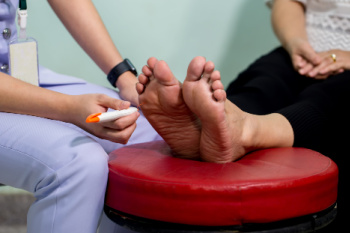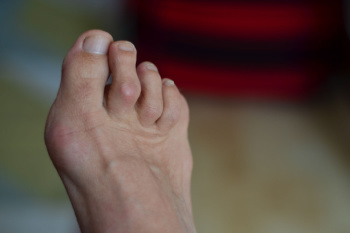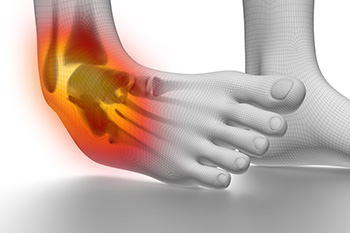Items filtered by date: June 2025
Get Professional Care for a Broken Foot or Ankle
Foot Problems in Pregnancy

During pregnancy, many women experience foot problems due to changes in weight, hormones, and circulation. One common issue is swelling in the feet and ankles, caused by fluid buildup and pressure from the growing uterus. Hormonal changes can loosen ligaments in the feet, sometimes causing the arches to fall and leading to flat feet or overpronation, which means the foot rolls inward when walking. This can cause pain in the arches or heels. Weight gain during pregnancy also increases pressure on the feet, often resulting in plantar fasciitis, a condition where the band of tissue along the bottom of the foot becomes irritated. Additionally, some women notice toenail changes, such as ridges or discoloration, and even an increased shoe size due to foot structure changes. A podiatrist can help relieve discomfort, address structural changes, and prevent more serious complications by recommending professional care options. If you are experiencing foot pain during pregnancy, it is suggested that you schedule an appointment with a podiatrist for appropriate care.
Pregnant women with swollen feet can be treated with a variety of different methods that are readily available. For more information about other cures for swollen feet during pregnancy, consult with Evan Young, DPM from Trinity Foot & Ankle . Our doctor will attend to all of your foot and ankle needs.
What Foot Problems Can Arise During Pregnancy?
One problem that can occur is overpronation, which occurs when the arch of the foot flattens and tends to roll inward. This can cause pain and discomfort in your heels while you’re walking or even just standing up, trying to support your baby.
Another problem is edema, or swelling in the extremities. This often affects the feet during pregnancy but tends to occur in the later stages.
How Can I Keep My Feet Healthy During Pregnancy?
- Wearing orthotics can provide extra support for the feet and help distribute weight evenly
- Minimize the amount of time spent walking barefoot
- Wear shoes with good arch support
- Wear shoes that allow for good circulation to the feet
- Elevate feet if you experience swelling
- Massage your feet
- Get regular, light exercise, such as walking, to promote blood circulation to the feet
If you have any questions, please feel free to contact our office located in Trinity, FL . We offer the newest diagnostic and treatment technologies for all your foot care needs.
Managing Nerve Damage in the Feet

Nerve damage in the feet, particularly involving the nerves between the toes, may lead to pain in the ball of the foot, also termed metatarsalgia. This type of nerve damage may result in a neuroma, which is a benign thickening of nerve tissue, commonly found between the third and fourth toes. Tight or poorly fitted shoes, reduced fat padding in the foot, and structural foot issues may place excessive pressure on these nerves. Symptoms of neuropathy include a mild ache or tingling in the toes, often becoming more intense with certain footwear. As the condition progresses, a patient may feel persistent burning pain or the sensation of having a pebble inside the shoe. A podiatrist may recommend footwear changes, orthotic devices, or injections. If conservative methods fail, surgery may be required to remove the affected nerve. If you have foot problems related to nerve damage in the feet, it is suggested that you schedule an appointment with a podiatrist.
Neuropathy
Neuropathy can be a potentially serious condition, especially if it is left undiagnosed. If you have any concerns that you may be experiencing nerve loss in your feet, consult with Evan Young, DPM from Trinity Foot & Ankle . Our doctor will assess your condition and provide you with quality foot and ankle treatment for neuropathy.
What Is Neuropathy?
Neuropathy is a condition that leads to damage to the nerves in the body. Peripheral neuropathy, or neuropathy that affects your peripheral nervous system, usually occurs in the feet. Neuropathy can be triggered by a number of different causes. Such causes include diabetes, infections, cancers, disorders, and toxic substances.
Symptoms of Neuropathy Include:
- Numbness
- Sensation loss
- Prickling and tingling sensations
- Throbbing, freezing, burning pains
- Muscle weakness
Those with diabetes are at serious risk due to being unable to feel an ulcer on their feet. Diabetics usually also suffer from poor blood circulation. This can lead to the wound not healing, infections occurring, and the limb may have to be amputated.
Treatment
To treat neuropathy in the foot, podiatrists will first diagnose the cause of the neuropathy. Figuring out the underlying cause of the neuropathy will allow the podiatrist to prescribe the best treatment, whether it be caused by diabetes, toxic substance exposure, infection, etc. If the nerve has not died, then it’s possible that sensation may be able to return to the foot.
Pain medication may be issued for pain. Electrical nerve stimulation can be used to stimulate nerves. If the neuropathy is caused from pressure on the nerves, then surgery may be necessary.
If you have any questions, please feel free to contact our office located in Trinity, FL . We offer the newest diagnostic and treatment technologies for all your foot care needs.
Causes and Treatment of Hammertoe

Hammertoe is a deformity in which one or more of the smaller toes, most commonly the second toe, bends abnormally at the middle joint, often creating a Z-shaped angle. A hammertoe may develop due to tendon imbalances, long toe bones, joint misalignment, or long-term use of wearing tight shoes. Rheumatoid arthritis can also be a contributing factor. People with hammertoe often experience pain when wearing shoes with a narrow toe box. Friction within the shoe can lead to the formation of corns, calluses, or even open sores on the top of the bent toe. Pain may also occur in the ball of the foot. After examining the hammertoe, a podiatrist may recommend custom orthotics to reduce pressure and relieve discomfort. In cases where the toe deformity becomes rigid and painful, surgery may be considered to realign the joints in the toe. If you have a hammertoe deformity that is causing pain, it is suggested that you schedule an appointment with a podiatrist for an exam and appropriate treatment options.
Hammertoe
Hammertoes can be a painful condition to live with. For more information, contact Evan Young, DPM from Trinity Foot & Ankle . Our doctor will answer any of your foot- and ankle-related questions.
Hammertoe is a foot deformity that affects the joints of the second, third, fourth, or fifth toes of your feet. It is a painful foot condition in which these toes curl and arch up, which can often lead to pain when wearing footwear.
Symptoms
- Pain in the affected toes
- Development of corns or calluses due to friction
- Inflammation
- Redness
- Contracture of the toes
Causes
Genetics – People who are genetically predisposed to hammertoe are often more susceptible
Arthritis – Because arthritis affects the joints in your toes, further deformities stemming from arthritis can occur
Trauma – Direct trauma to the toes could potentially lead to hammertoe
Ill-fitting shoes – Undue pressure on the front of the toes from ill-fitting shoes can potentially lead to the development of hammertoe
Treatment
Orthotics – Custom made inserts can be used to help relieve pressure placed on the toes and therefore relieve some of the pain associated with it
Medications – Oral medications such as anti-inflammatories or NSAIDs could be used to treat the pain and inflammation hammertoes causes. Injections of corticosteroids are also sometimes used
Surgery – In more severe cases where the hammertoes have become more rigid, foot surgery is a potential option
If you have any questions, please feel free to contact our office located in Trinity, FL . We offer the newest diagnostic and treatment technologies for all your foot care needs.
Severity Levels of Ankle Sprains and a Podiatrist’s Role

Ankle sprains occur when the ligaments that support the ankle are stretched or torn, often due to a sudden twist, fall, or misstep on uneven surfaces. This injury is common in sports and daily activities that involve quick changes in direction. Ankle sprains are classified into three grades. A mild sprain, or Grade 1, involves slight stretching of the ligament, while a moderate sprain, or Grade 2, includes partial tearing and more noticeable swelling. A severe sprain, or Grade 3, means the ligament is fully torn, leading to significant instability. Symptoms can include pain, swelling, bruising, and difficulty walking. A podiatrist can evaluate the injury, recommend the appropriate treatment, and provide supportive devices to promote proper healing. If you have sprained your ankle, it is suggested that you promptly contact a podiatrist who can accurately diagnose and treat ankle sprains.
Although ankle sprains are common, they aren’t always minor injuries. If you need your ankle injury looked at, contact Evan Young, DPM from Trinity Foot & Ankle . Our doctor can provide the care you need to keep you pain-free and on your feet.
How Does an Ankle Sprain Occur?
Ankle sprains are the result of a tear in the ligaments within the ankle. These injuries may happen when you make a rapid shifting movement while your foot is planted. A less common way to sprain your ankle is when your ankle rolls inward while your foot turns outward.
What Are the Symptoms?
- Pain at the sight of the tear
- Bruising/Swelling
- Ankle area is tender to touch
- In severe cases, may hear/feel something tear
- Skin discoloration
Preventing a Sprain
- Wearing appropriate shoes for the occasion
- Stretching before exercises and sports
- Knowing your limits
Treatment of a Sprain
In many cases, the RICE method (Rest, Ice, Compression, and Elevate) is used to treat ankle sprains. However, you should see a podiatrist to see which treatment option would work best with your injury. In severe cases, surgery may be required.
It is important to ask your doctor about rehab options after you receive treatment for your injury. Stretching, strength training, and balance exercises may help the ankle heal while also preventing further injury.
If you have any questions, please feel free to contact our office located in Trinity, FL . We offer the newest diagnostic and treatment technologies for all your foot care needs.

